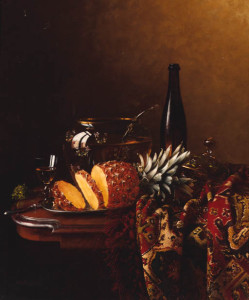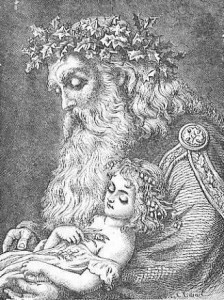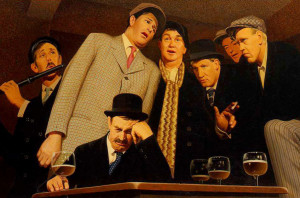SEVENTH DAY of CHRISTMAS
New Year’s Day
The toast “Wassail!” is a hearty one. Go on, say it. It sounds a lot more magical than the toasts we tend to use nowadays upon lifting a glass in good company. “Cheers!” just doesn’t have the same potency as “Wassail!” Indeed, wassail is derived from the Old English Wes Hel: Be of good health. It is both a toast and a drink, and on this first day of the year, this seventh day of Christmas, wassailing is customary. We wassail each other, we wassail the trees from whence comes our wine, our cider, our ale. All of it––the transformation of seed to tree, of juice to libation––a bit of magic in the form of everyday alchemy.
There are many kinds of wassail made from all sorts of ingredients, but here’s the recipe we share with you each year for a good wassail: Pour the contents of two large bottles of beer or ale (about 4 pints) into a pot and place it on the stove to heat slowly. Add about a half cup sugar and a healthy dose of mulling spices. (If you don’t have mulling spices on hand, you can use cinnamon sticks and whole cloves… though the mulling spices lend a more interesting flavor.) Add a half pint each of orange juice and pineapple juice, as well as the juice of a large lemon. Peel and slice two apples and place the apple slices into the pot, too. Heat the brew but don’t let it boil, then pour the heated wassail into a punch bowl to serve.
Punches of this nature were more popular in times past, but I think it’s high time for a revival. I love the ceremony of a punch, from the concocting to the ladeling of the steaming drink from a punch bowl into cups. The true custom for the day would have us gather around an apple tree at noon with our wassail punch and drink a hearty wassail to each other and to the tree. Usually it’s the oldest apple tree in the orchard. We don’t have apple trees here in Lake Worth, so here we know all about improvising; feel free to improvise yourself. It’s the spirit of wassailing that is most important and not so much the small details. It’s quite all right if you can’t get out there at noon, too. Here’s an old song to sing or shout out as you wassail the trees:
Here’s to thee, old apple tree
Whence thou may’st bud and
whence thou may’st blow,
And whence thou may’st
bear apples enow.
Hats full, Caps full, Bushel,
bushel sacks full,
And my pockets full, too!
Huzzah!
The wish is for abundance. And so on this first day of the new year, we wish you all abundance and good health, too. Wes Hel! Wassail! And Huzzah as well!
Image: “Eine Bowle, eine Ananas und ein Teppich auf einem Tisch” ( a bowl of punch, with a pineapple and a carpet on a table) by Georg Heinrich Brandes. Oil on canvas, c. 1800s. [Public domain] via Wikimedia Commons.


